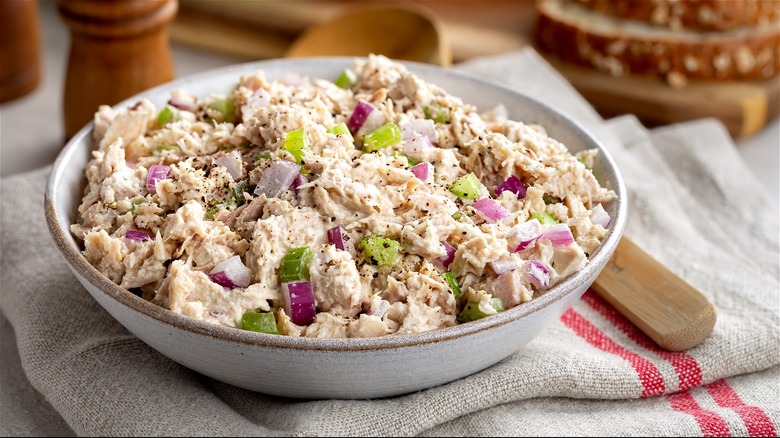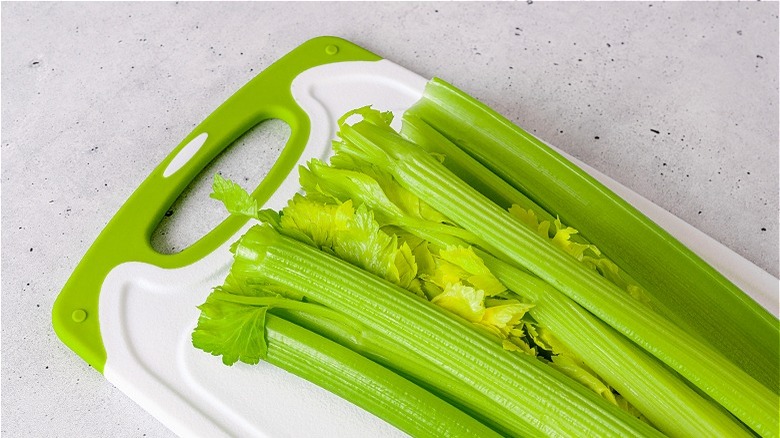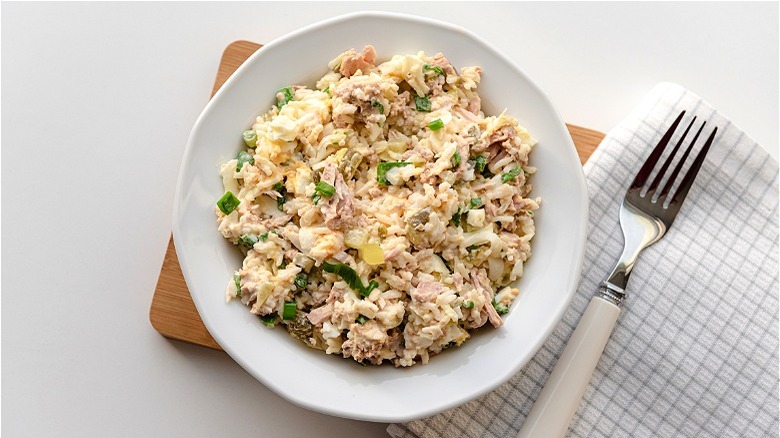It's Best To Peel Celery Before Adding It To Your Tuna Salad
When you're in the mood for a real American lunch, you can always turn to a melty grilled cheese or a classic club sandwich to satisfy that craving, or you can stick with a traditional mainstay like tuna salad. It's a convenient meal to prepare last minute since you probably have a few cans of tuna taking up space in your pantry right now. Bread also isn't necessary when it comes to enjoying this protein-rich salad: crackers or just a fork do the trick without skimping in the satisfaction department.
Tuna salad's versatility can be traced back to the reason for its existence. Meat-based salads were a way for consumers to use up leftover bits of food throughout the 1800s. The earliest versions of this classic American staple are synonymous with the most common varieties made today: tuna salad is typically mixed with mayonnaise, a bit of mustard, spices of your choosing, and lastly, minced red onion and celery. While finely chopping these fresh vegetables is often recommended so they blend together nicely with small, flaky chunks of tuna, there is one vital step you may not want to forget as you head to your kitchen to make another batch. Surprisingly, you may want to peel celery before chopping and adding it to your favorite tuna salad recipe — doing so may indefinitely lead to a more enjoyable eating experience.
Is peeling celery really necessary?
When you make your traditional tuna salad recipe, you may be in a time crunch and simply don't have the extra minutes to peel celery or finely dice those raw vegetables. However, peeling celery may ultimately save your teeth from painstakingly chomping through this vegetable's fibrous outer layer. Since celery grows in the ground, the University of Wyoming recommends separating each rib from the stalk and washing each separately to remove any excess dirt or debris. If you find the particular bunch of celery you have stored in your refrigerator has an extra tough exterior, run your vegetable peeler along each rib's length to remove any tough strings. Alternatively, you may choose to use a knife to remove the outer layer since you can get to the heart of the problem with more hand control without accidentally removing too much of the vegetable.
Peeling celery isn't always necessary, but when you're planning to enjoy this crunchy vegetable raw, and especially in a creamy salad with softer components, peeling may give your teeth a much-welcomed break. Chef Lizzy Briskin told Insider she always removes celery's outer layer when making tuna or pasta salad for a more pleasurable eating experience. If you want to avoid the extra chewing but don't have time to peel celery for your next batch of tuna salad, you're in luck since there are many delicious swaps you can make for this hearty green vegetable.
Tasty tuna salad swaps
Even though, according to Healthline, consuming celery comes with copious amounts of health benefits including considerable amounts of vitamin C and dietary fiber, not every single adult enjoys eating this anti-inflammatory vegetable. Celery's makeup is quite crisp and undoubtedly crunchy, so if you want something a little more mellow but just as fresh in taste, there are a number of convenient swaps you can make.
Did you know there are roughly 15 ingredients you can use to replace celery in tuna salad? To make a simple swap using fresh vegetables, grated carrots provide a similar crunch without that distinct celery flavor. If you're feeling the desire to get more creative, you might try Primavera Kitchen's unique recipe which uses avocado and cucumber as the veggie base for a healthier tuna salad. For swaps that are sure to deliver in the flavor department, Love & Olive Oil uses capers and sweet relish. These two small additions pack a delightful punch of flavor to your tuna salad without completely overtaking that signature tuna taste. In fact, adding relish and other pickled condiments proved to be quite common in the earlier days of tuna salad when families were trying their hardest to use any leftover ingredients they had on hand. Whether you opt for celery, pickled relish, or capers, there are plenty of vegetable swaps perfect for a classic tuna salad recipe. Just don't forget the mayo.


